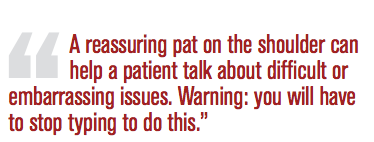Article
How to stay engaged with patients-in spite of your EHR
Today’s physicians are busier than ever tackling high-volume schedules, chasing quality metrics and interpreting scads of data flowing into the electronic health record (EHR) 24 hours a day, seven days a week.

Dr. RouscheToday’s physicians are busier than ever tackling high-volume schedules, chasing quality metrics and interpreting scads of data flowing into the electronic health record (EHR) 24 hours a day, seven days a week. Processing the labs, imaging results and correspondence letters is interesting, but can be mundane. The great joy in medicine is interacting with the patients. Connecting with patients, and getting to know their stories is of utmost importance for both patient and physician satisfaction.
There is an easy five-ingredient recipe to guarantee patient satisfaction and connection in today’s world of electronic medicine, and still be happy at the end of the work day. Simply follow the P-FETA system.
The P in the P-FETA system is the only action taken outside of the examination room. P stands for pre-chart. You do not want to enter the patient’s room unprepared. Take some time before the office visit to go over what has happened to the patient since you’ve last seen him or her. This can take two minutes, or 15 minutes, depending on how complex the patient is, and may need to be done the night before rather than in the hallway just before the visit.
I do this on the weekends, so I am ready to enter the room on time, without any significant delay. Many patients have had X-rays, CT scans, cardiology visits or admissions since their last time in the office, and you don’t want to sit in front of the patient reviewing this information. This will cause “eye lock,” which is bad for patient engagement. Eye lock is a phenomenon whereby your eyes are stuck on the computer screen, and not looking at your patient.
Patients hate this. They also dislike when their doctor is not aware that they were hospitalized. Take time outside of the room to review this information and be prepared when you walk in the room.
The F in the P-FETA system stands for face the patient. There is nothing worse for a patient than trying to speak with their doctor about personal health issues while staring at their doctor’s back. It is downright rude to have your back to your patient typing while they talk.
Rearrange every exam room so that you can face the patient. Put your computer on a surface low enough that you can look over the top of the screen and see the patient. This goes a long way toward making the patient feel comfortable and acknowledged. You can’t practice truly good medicine with your back to your patient.
E is for eye contact. Be sure to make eye contact after every sentence that you type. Even if you just lift your eyes up with a quick flip over the top of your screen so that the patient and you connect for half a second. No one wants to have a conversation with another person who is not looking at them.
For example, we have all had a conversation with a teenager who doesn’t bother to look up from her cell phone to show that she’s listening. It is annoying when you try to talk with a person and they don’t bother to look at you.
If your patient is discussing a serious subject, such as the death of a spouse, a child’s addiction issues or a new cancer diagnosis, have the decency to stop typing. Yes, you should interrupt your typing to really listen and look at your patient. It is common courtesy.

T is for touch. Nothing helps to create a connection with another human being so much as the laying on of hands. Be physically close enough to the patient to be able to put your hand on their knee during the history-taking part of the exam. When your patient starts crying about their major depression, stop typing, and touch your patient. Even a quick squeeze of the hand sends a strong message that you really care.
A reassuring pat on the shoulder can help a patient talk about difficult or embarrassing issues. Warning: you will have to stop typing to do this, but it is necessary for connecting with your patient and the hiatus from the keyboard is brief.
A is for afterward. This is the period after you have examined the patient and established the plan and follow-up, but before you leave the room. This is the time for completely abandoning the computer and closing the interview in a personal way. The computer needs to be out of picture for this part of the visit. The afterward is the time to look only at the patient and to discuss, albeit briefly, a non-medical issue.
You need to close the interview by making a personal connection with the patient. If you know them well, this is the time to ask about the grandchildren, or how their garden is doing. If they are not as well known to you, it is the time to ask about their job, or simply talk about the weather.
Patients appreciate this one- to three-minute gesture more than you can imagine. It shows a human side of their doctor. This communication cannot be done with a computer screen open between you and the patient. It just won’t be as effective if you try to ask these questions still staring at your screen trying to check off your metrics boxes.
In conclusion, the P-FETA system is the best way to remain engaged with your patients while trying to fulfill the requirements of electronic medical record charting. Both physicians and patients will be more satisfied with today’s healthcare visits if the doctor leaves the P outside, and brings the cheese (FETA) in the room.





